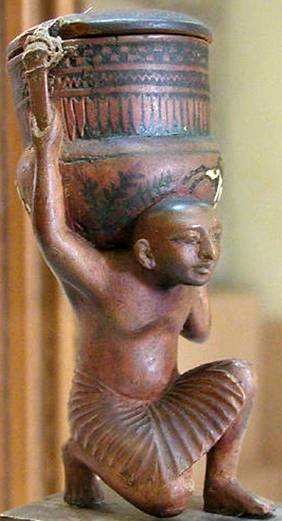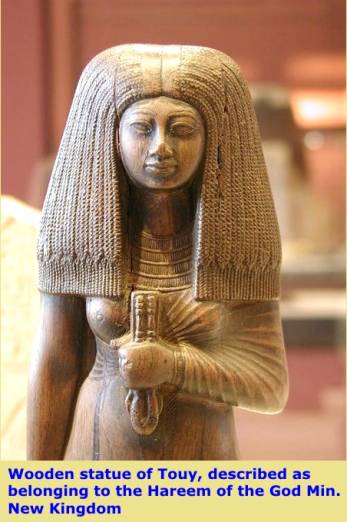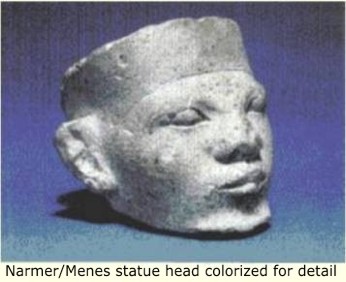Religion and everyday life

As
mentioned before, the religion of Neolithic (late stone age) and
pre-dynastic Egypt appears to have been animistic/nature worship, where
each village or town had its own spirit deity in the form of an animal,
bird, reptile, tree, plant or object. This spirit was always in
something that played a prominent part in the life of the people. The
spirits fell into two general categories, those which were friendly and
helpful, such as cattle, or those that were menacing and powerful such
as Bulls, crocodiles or snakes. In both cases, the favor of the spirit
had to be solicited with a set formula of words and actions, and the
spirits also had to have houses built for them, and offerings made to
them.
As these spirits evolved into gods, the deity then had
to have its own special type of house built, a temple. This building
would then need full-time staff, to attend to the gods wants and needs,
such as performing the proper rituals, making the proper offerings etc,
and also to administer the gods blessings back to the people - the
Priests. Since the Kings own divinity was legitimized by the
priesthood, it was also very necessary to insure that the temple and
priesthood were properly provided for.
So in addition to the offerings from the people, the
temple was given large land grants, to insure a source of income. Then
of course, the god would need a wife - a high priestess. Here, as with
the priests, there was a hierarchy, from the high priestess herself, to
the lowest level priestesses, who preformed household chores and often
served as temple prostitutes. In return for these services, the god was
thought to protect its people, ensuring fertility and well-being. But
if the gods needs weren't met, the deity might bring down wrath on the
community, in the form of plague, famine or some such natural disaster.
The insignia or standard of a Nome clearly showed which god protected
the town, and as the town gained prominence, so too did the town's god.
Religion was interwoven, not only into the pharaohs
power, but into life itself. It was the deity of a town who the people
turned to, in order to prevent the everyday hazards of living. They used
magic spells, charms, folklore and amulets to appealed to the deity for
protection against hazards, and to intercede on their behalf, for
anything from the Nile flooding, to sowing seeds and harvesting crops,
to protection from poisonous snakes, and for safe childbirth.
 |

Horus
and Nekhbet {the vulture goddess}, came to represent Upper Egypt. In
Lower Egypt, it was Set/Seth and Udjo, and also the cobra goddess of
Buto. In later Egyptian history, the vulture and cobra were united into
the royal diadem, to represent dominion over both lands. So when Nekhem
became the most powerful town, Horus became the main god. The rulers
started to identify themselves as the living embodiment of the hawk god.
The ability to grow of Egyptian religion is one of the reasons why
Egypt ended up with such a complex and polytheistic religious system.
When a town grew in prominence, so too did the god. When the town was
deserted, the god disappeared.
Only a few of the many original deities ended up in
the Egyptian pantheon, and even then, their popularity waxed and waned
through the thousands of years of Egyptian history. Another reason for
complexity was that when people moved, their god did too. This meant
that at the new town, there was sometimes a battle between the old and
new gods - but the Egyptian gods were easily merged, so that you would
have one god taking over the other god's attributes and abilities. That
is why, some of the ancient gods of Neolithic and Pre-dynastic Egypt,
those that had maintained their popularity, became main gods in the
later Egyptian pantheon: Amun of Thebes, Ptah of Hikuptah (Memphis),
Horus (the Elder) of Nekhem, Set/Seth of Tukh (Ombos), Ra of Iunu
(Heliopolis), Min of Gebtu (Koptos), Hathor of Dendra and Osiris of
Abydos.
Food

Egyptians
had a very varied diet, they grew wheat and other cereal grains from
which they made breads, and brewed many varieties of beer. They grew a
large variety of fruits, which they ate fresh or dried, they also grew
grapes, which were eaten fresh or dried, but also with which they made a
great variety of wines. They also grew a wide variety of vegetables.
They ate beef, fowl, fish and game animals, and pork - contrary to
popular belief, Egyptians did eat pork.
As a matter of fact, the only food prohibition in the
ancient world that we can find, is the Nubian ban on "FISH" (ya fish -
go figure). They felt that fish were unclean, and the king wouldn't give
audience to anyone who had eaten fish. (The logic here may have been
based on the fact that, some fish - like pork, can have worms in the
flesh, and will make a person ill, if not cooked properly, that's our
guess!). Egyptians had many sources of oil, but they preferred olive
oil, which they used for cooking, lighting and as an oil for the skin.
Clothing
Egyptian climate with its hot summers and mild winters
favored light clothing made from plant fibers, predominantly linen. The
manufacture of clothes was women's work. It was mostly done at home,
but there were workshops run by noblemen or other men of means. Fibers
were made by beating and combing the flax plant, which could then be
spun into thread. The weaving was done at first on horizontal looms,
which were often just pegs rammed into the ground, but later they
developed vertical looms.
Their tools such as knives and needles changed over
the centuries. Blades were made from stone during the Neolithic, then
from copper, and from bronze during the Middle Kingdom and finally from
iron. Though flint knives, which had sharper edges than iron ones,
continued to be used, ever decreasingly until Roman times. Needles were
fashioned from wood, bone and metal. The Egyptians succeeded in making
extremely thin millimeter thick eyes in copper needles. Scissors came
into general use late in Egypt's history, though the principle was known
since the second millennium B.C.
hygiene

Because
of its hot climate, in Egypt shaving and hair removal was a regular
part of daily grooming. The Egyptians had an unusual obsession with
personal body hygiene. The great Greek historian/storyteller HERODOTUS,
stated that the Egyptians bathed several times a day, and "set cleanness
above seemliness."
Clearly, being so clean all the time, was associated
with fanatical behavior by outsiders. The ancient Romans thought that a
lack of body hair, was some kind of terrible deformity. But not in
Egypt, people there believed that body hair was shameful and unclean.
Wild animals and barbarian people had hair, not the sophisticated,
super-advanced Egyptian civilization.
Being hairless was accomplished by shaving, or using
depilatory creams, and even rubbing one’s hair off with a pumice stone.
Men, women, and even the children of ancient Egypt, all shaved their
heads bald and wore elaborate specially-made wigs. These wigs were made
of natural or artificial hair, and were specially designed to keep
one’s head cool.
The Greek historian/storyteller "Herodotus" maintained
that it was the Egyptians, who invented circumcision, and all who
practiced it, learnt it from them. Which logically follows, because
there is a hygienic value to circumcision. If not kept scrupulously
clean, a male can have problems there - it's not all about torturing
little boys.
Science
There is always an argument as to whether it was the
Sumerians, Egyptians or Indus valley people, who invented writing,
mathematics, astronomy, calendars etc, etc, etc. As soon as a site is
discovered that proves the one, another site is discovered that proves
the other. Suffice to say that they were contemporary with each other,
and in contact with each other. Though logically you could say that all
things originated in Egypt. So far though, no one has disproved that the
Sumerians invented the wheel and wagon. Although it was the Egyptians,
who took the wagon to its highest refinement, with their light and agile
chariots.
In writing, the Egyptians eventually came to use two
scripts for their language. Hieroglyphics recorded their language with a
mixed system of sound signs and picture signs. Demotic script is a
more cursive development of the hieratic script, it was the standard
script for business and legal affairs throughout the country;
Hieroglyphics was retained for writing religious texts and inscriptions
on monuments.
The Egyptians followed a calendar system of 360 days,
with three seasons, each made up of 4 months, with thirty days in each
month. The seasons of the Egyptians, corresponded to the cycles of the
Nile, and were known as Inundation (pronounced akhet which lasted from
June 21st to October 21st), Emergence (pronounced proyet which lasted
from October 21st to February 21st), and Summer (pronounced shomu which
lasted from February 21st to June 21st).
The beginning of the year, also called "the opening of
the year", was marked by the emergence of the star Sirius in the
constellation of Canis Major. The constellation emerged roughly on June
21st, and was called "the going up of the goddess Sothis". The star was
visible just before sunrise, and is still one of the brightest stars in
the sky, located to the lower left of Orion and taking the form of the
dogs nose in the constellation Canis Major.
Though the Egyptians had a 360 day calendar, in a literal sense, they did
have a 365 day calendar system. The beginning of the year was marked by
the addition of five days, known as "the yearly five days". These
additional five days were times of great feasting and celebration for
the Egyptians, and it was not uncommon for the Egyptians to perform
rituals, and other celebratory dealings on these days.
Source: http://www.realhistoryww.com/
 As
mentioned before, the religion of Neolithic (late stone age) and
pre-dynastic Egypt appears to have been animistic/nature worship, where
each village or town had its own spirit deity in the form of an animal,
bird, reptile, tree, plant or object. This spirit was always in
something that played a prominent part in the life of the people. The
spirits fell into two general categories, those which were friendly and
helpful, such as cattle, or those that were menacing and powerful such
as Bulls, crocodiles or snakes. In both cases, the favor of the spirit
had to be solicited with a set formula of words and actions, and the
spirits also had to have houses built for them, and offerings made to
them.
As
mentioned before, the religion of Neolithic (late stone age) and
pre-dynastic Egypt appears to have been animistic/nature worship, where
each village or town had its own spirit deity in the form of an animal,
bird, reptile, tree, plant or object. This spirit was always in
something that played a prominent part in the life of the people. The
spirits fell into two general categories, those which were friendly and
helpful, such as cattle, or those that were menacing and powerful such
as Bulls, crocodiles or snakes. In both cases, the favor of the spirit
had to be solicited with a set formula of words and actions, and the
spirits also had to have houses built for them, and offerings made to
them.
 Horus
and Nekhbet {the vulture goddess}, came to represent Upper Egypt. In
Lower Egypt, it was Set/Seth and Udjo, and also the cobra goddess of
Buto. In later Egyptian history, the vulture and cobra were united into
the royal diadem, to represent dominion over both lands. So when Nekhem
became the most powerful town, Horus became the main god. The rulers
started to identify themselves as the living embodiment of the hawk god.
The ability to grow of Egyptian religion is one of the reasons why
Egypt ended up with such a complex and polytheistic religious system.
When a town grew in prominence, so too did the god. When the town was
deserted, the god disappeared.
Horus
and Nekhbet {the vulture goddess}, came to represent Upper Egypt. In
Lower Egypt, it was Set/Seth and Udjo, and also the cobra goddess of
Buto. In later Egyptian history, the vulture and cobra were united into
the royal diadem, to represent dominion over both lands. So when Nekhem
became the most powerful town, Horus became the main god. The rulers
started to identify themselves as the living embodiment of the hawk god.
The ability to grow of Egyptian religion is one of the reasons why
Egypt ended up with such a complex and polytheistic religious system.
When a town grew in prominence, so too did the god. When the town was
deserted, the god disappeared. Egyptians
had a very varied diet, they grew wheat and other cereal grains from
which they made breads, and brewed many varieties of beer. They grew a
large variety of fruits, which they ate fresh or dried, they also grew
grapes, which were eaten fresh or dried, but also with which they made a
great variety of wines. They also grew a wide variety of vegetables.
They ate beef, fowl, fish and game animals, and pork - contrary to
popular belief, Egyptians did eat pork.
Egyptians
had a very varied diet, they grew wheat and other cereal grains from
which they made breads, and brewed many varieties of beer. They grew a
large variety of fruits, which they ate fresh or dried, they also grew
grapes, which were eaten fresh or dried, but also with which they made a
great variety of wines. They also grew a wide variety of vegetables.
They ate beef, fowl, fish and game animals, and pork - contrary to
popular belief, Egyptians did eat pork.  Because
of its hot climate, in Egypt shaving and hair removal was a regular
part of daily grooming. The Egyptians had an unusual obsession with
personal body hygiene. The great Greek historian/storyteller HERODOTUS,
stated that the Egyptians bathed several times a day, and "set cleanness
above seemliness."
Because
of its hot climate, in Egypt shaving and hair removal was a regular
part of daily grooming. The Egyptians had an unusual obsession with
personal body hygiene. The great Greek historian/storyteller HERODOTUS,
stated that the Egyptians bathed several times a day, and "set cleanness
above seemliness."  In
the next period, known as Naqada III, Egypt has by now, been split-up
into many administrative/territorial divisions, known as Nomes. Each
nome has it's own sacred animal or plant that became the totem, or
emblem of that nome. This emblem was usually depicted on the pottery of
each nome. It is also at this time that we see Egypt referred to as -
Upper and Lower Egypt - with twenty nomes in Lower Egypt and
twenty-two in Upper Egypt. Each nome had its own ruler, but perhaps with
an over-all ruler. It is not known what the original political make-up
was, or how many times if any, there was unity and then a break-up.
In
the next period, known as Naqada III, Egypt has by now, been split-up
into many administrative/territorial divisions, known as Nomes. Each
nome has it's own sacred animal or plant that became the totem, or
emblem of that nome. This emblem was usually depicted on the pottery of
each nome. It is also at this time that we see Egypt referred to as -
Upper and Lower Egypt - with twenty nomes in Lower Egypt and
twenty-two in Upper Egypt. Each nome had its own ruler, but perhaps with
an over-all ruler. It is not known what the original political make-up
was, or how many times if any, there was unity and then a break-up.



 In
any event, there is general agreement that Narmer should be credited as
the unifier of Egypt, and hence the first Pharaoh of the first Dynasty.
Whether or not, this is the first unification of Egypt is unknown.
During the Early Dynastic period, the king of ancient Egypt already had
much of the trappings of royal regalia familiar from later times,
including the double crowns of Upper and Lower Egypt and various
scepters. These crowns, scepters and other elements, offered and
represented power and protection. They also set the king apart from
everyone else and conveyed his authority, both secular and religious.
In
any event, there is general agreement that Narmer should be credited as
the unifier of Egypt, and hence the first Pharaoh of the first Dynasty.
Whether or not, this is the first unification of Egypt is unknown.
During the Early Dynastic period, the king of ancient Egypt already had
much of the trappings of royal regalia familiar from later times,
including the double crowns of Upper and Lower Egypt and various
scepters. These crowns, scepters and other elements, offered and
represented power and protection. They also set the king apart from
everyone else and conveyed his authority, both secular and religious.


